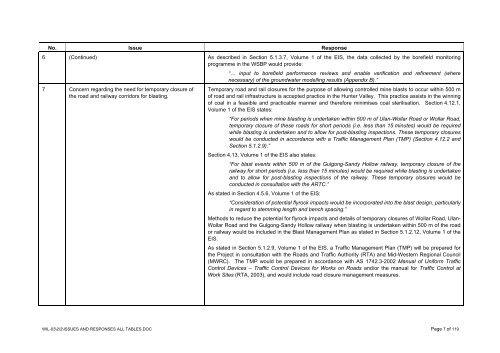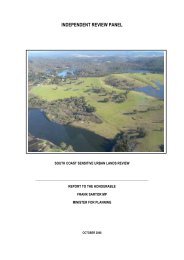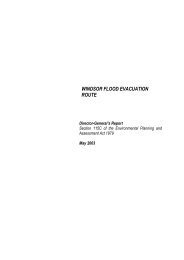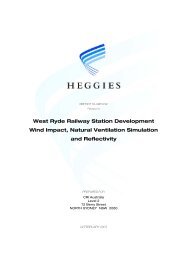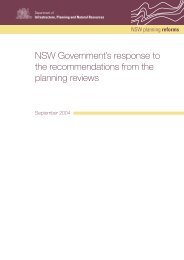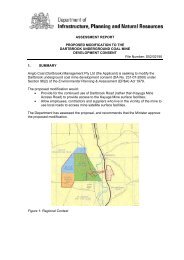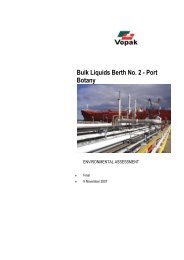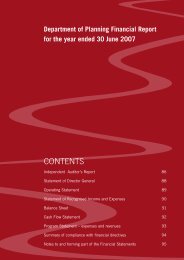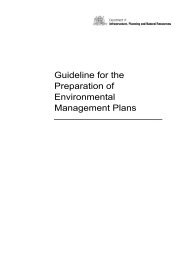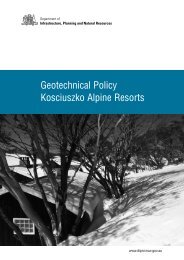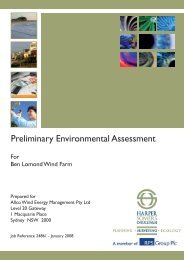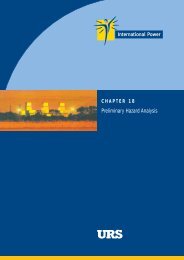wilpinjong coal project wilpinjong coal project - Department of ...
wilpinjong coal project wilpinjong coal project - Department of ...
wilpinjong coal project wilpinjong coal project - Department of ...
Create successful ePaper yourself
Turn your PDF publications into a flip-book with our unique Google optimized e-Paper software.
No. Issue Response<br />
6 (Continued) As described in Section 5.1.3.7, Volume 1 <strong>of</strong> the EIS, the data collected by the borefield monitoring<br />
programme in the WSBP would provide:<br />
7 Concern regarding the need for temporary closure <strong>of</strong><br />
the road and railway corridors for blasting.<br />
“… input to borefield performance reviews and enable verification and refinement (where<br />
necessary) <strong>of</strong> the groundwater modelling results (Appendix B).”<br />
Temporary road and rail closures for the purpose <strong>of</strong> allowing controlled mine blasts to occur within 500 m<br />
<strong>of</strong> road and rail infrastructure is accepted practice in the Hunter Valley. This practice assists in the winning<br />
<strong>of</strong> <strong>coal</strong> in a feasible and practicable manner and therefore minimises <strong>coal</strong> sterilisation. Section 4.12.1,<br />
Volume 1 <strong>of</strong> the EIS states:<br />
“For periods when mine blasting is undertaken within 500 m <strong>of</strong> Ulan-Wollar Road or Wollar Road,<br />
temporary closure <strong>of</strong> these roads for short periods (i.e. less than 15 minutes) would be required<br />
while blasting is undertaken and to allow for post-blasting inspections. These temporary closures<br />
would be conducted in accordance with a Traffic Management Plan (TMP) (Section 4.12.2 and<br />
Section 5.1.2.9).”<br />
Section 4.13, Volume 1 <strong>of</strong> the EIS also states:<br />
“For blast events within 500 m <strong>of</strong> the Gulgong-Sandy Hollow railway, temporary closure <strong>of</strong> the<br />
railway for short periods (i.e. less than 15 minutes) would be required while blasting is undertaken<br />
and to allow for post-blasting inspections <strong>of</strong> the railway. These temporary closures would be<br />
conducted in consultation with the ARTC.”<br />
As stated in Section 4.5.6, Volume 1 <strong>of</strong> the EIS:<br />
“Consideration <strong>of</strong> potential flyrock impacts would be incorporated into the blast design, particularly<br />
in regard to stemming length and bench spacing.”<br />
Methods to reduce the potential for flyrock impacts and details <strong>of</strong> temporary closures <strong>of</strong> Wollar Road, Ulan-<br />
Wollar Road and the Gulgong-Sandy Hollow railway when blasting is undertaken within 500 m <strong>of</strong> the road<br />
or railway would be included in the Blast Management Plan as stated in Section 5.1.2.12, Volume 1 <strong>of</strong> the<br />
EIS.<br />
As stated in Section 5.1.2.9, Volume 1 <strong>of</strong> the EIS, a Traffic Management Plan (TMP) will be prepared for<br />
the Project in consultation with the Roads and Traffic Authority (RTA) and Mid-Western Regional Council<br />
(MWRC). The TMP would be prepared in accordance with AS 1742.3-2002 Manual <strong>of</strong> Uniform Traffic<br />
Control Devices – Traffic Control Devices for Works on Roads and/or the manual for Traffic Control at<br />
Work Sites (RTA, 2003), and would include road closure management measures.<br />
WIL-03\2\2\ISSUES AND RESPONSES ALL TABLES.DOC Page 7 <strong>of</strong> 119


